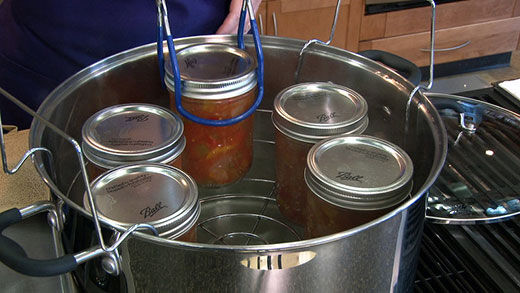There is nothing like the taste of fresh vegetables that come straight to the table from the garden, and often when there is a produce surplus folks turn to processing options such as freezing or canning to make it last throughout the year.
In anticipation of that summer season, food scientist Karen Blakeslee, who is also the coordinator of the Rapid Response Center for Food Science at Kansas State University, offers tips on how to have a successful canning experience.
“This is the time to make sure everything is working properly before you start canning,” Blakeslee said.
She said canning jars and rings can be reused if the jars are free of cracks and there is no rust on the rings. To keep damage from occurring, Blakeslee recommends hand-washing the rings to keep them from rusting prematurely. Lids, however, cannot be used more than once.
“Never reuse the lids; they are only to be used once because of the sealing compound gets indented and the lid will get bent when opening the jar,” Blakeslee said.
Along with checking the jars and rings, she also said it is important to inspect canners to make sure they are in working order. For example, with dial gauge canners, start by checking the valves and pressure gauge.
“You need to make sure the dial gauge is tested. That can be done through your local extension office,” Blakeslee said. We can only test four brands which include Presto, National, Maid of Honor and Magic Seal.
She also encourages people to check the seal between the pot and the lid, looking for cracks or dried rubber.
“If there are cracks in the seal, steam will leak out and the canner will never get to the proper pressure,” Blakeslee said. She added that the rubber plug can also wear out and will need to be replaced when it is damaged.
As far as preparing the food, Blakeslee recommends removing the peels to prevent unintended bacteria growth.
“When you can foods like potatoes and carrots, bacteria and dirt can get trapped in the cracks, so you will want to remove the peels before canning,” Blakeslee said. She adds that this is true of tomatoes, as well.
She encouraged people to follow tested canning recipes and not to improvise.
“There are a lot of tested recipes on our K-State Rapid Response Center website that would be good follow,” Blakeslee said.
After the jars have been processed, Blakeslee said they should be allowed to cool in an isolated area.
“I recommend putting a towel down on the counter with a cooling rack on top rather than putting the jars directly on the counter. Also, be sure to keep them away from drafts, so they are allowed to cool down naturally,” Blakeslee said.
Lastly, Blakeslee said to be sure to write the date that the food was canned on the lid before putting them into storage.
Blakeslee said: “It is important to put the date on the jars and try to use them within one year allowing you to rotate them out for the next year’s supply.”
Sign up for HPJ Insights
Our weekly newsletter delivers the latest news straight to your inbox including breaking news, our exclusive columns and much more.




